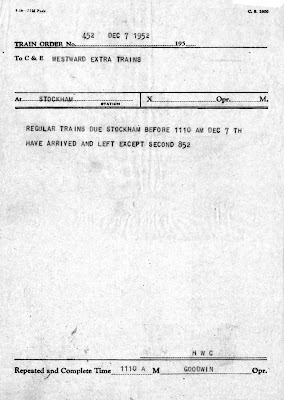In my previous post on this topic, I showed some SP train orders from the 1950 era. In response to a couple of requests, I will show more of them in this post. That previous post can be viewed at this link: http://modelingthesp.blogspot.com/2012/09/modeling-sp-train-orders.html .
The first one I show here is a simple “right over” order, but involves several trains and two different territories of rights. It was issued at Lathrop in 1950, and is addressed to First 426, an eastward freight train, with rights over westward trains which otherwise would have superiority by direction.
This next one is also simple, setting the location of a meet and directing which train is to take the siding. It was issued at Maricopa, Arizona in 1952.
A third one is quite interesting in that it identifies an oversize load. Most train orders are thought of as directing train movements, but this one, issued at Tucson in 1952, is a cautionary order.
Most model layout operators are familiar with the concept of a “train register,” which is located at critical points, often at terminals or important junctions. Crews sign it when arriving or departing, and its purpose is to show that scheduled trains have in fact departed or arrived (since timetable authority continues for 12 hours after the time shown in the timetable, there would otherwise be no way to be certain of such arrivals or departures). This 1952 train order serves the same purpose in notifying westward trains of the situation at Stockham (just west of Tucson) regarding other trains.
All these are interesting examples and can be food for thought in model layout operations. As mentioned in my original post on this topic (cited at the top of this post), there are good written explanations of how train orders worked, if this is new to you.
TonyThompson




No comments:
Post a Comment